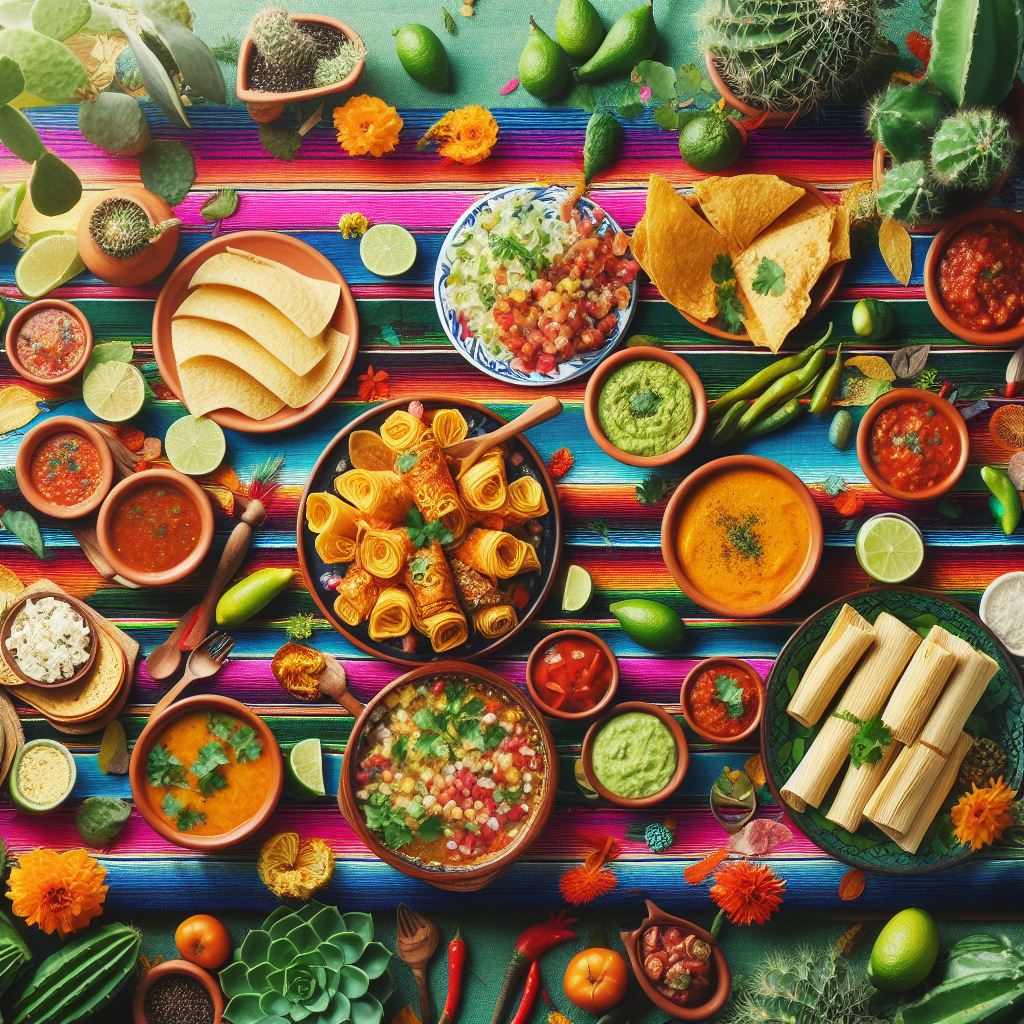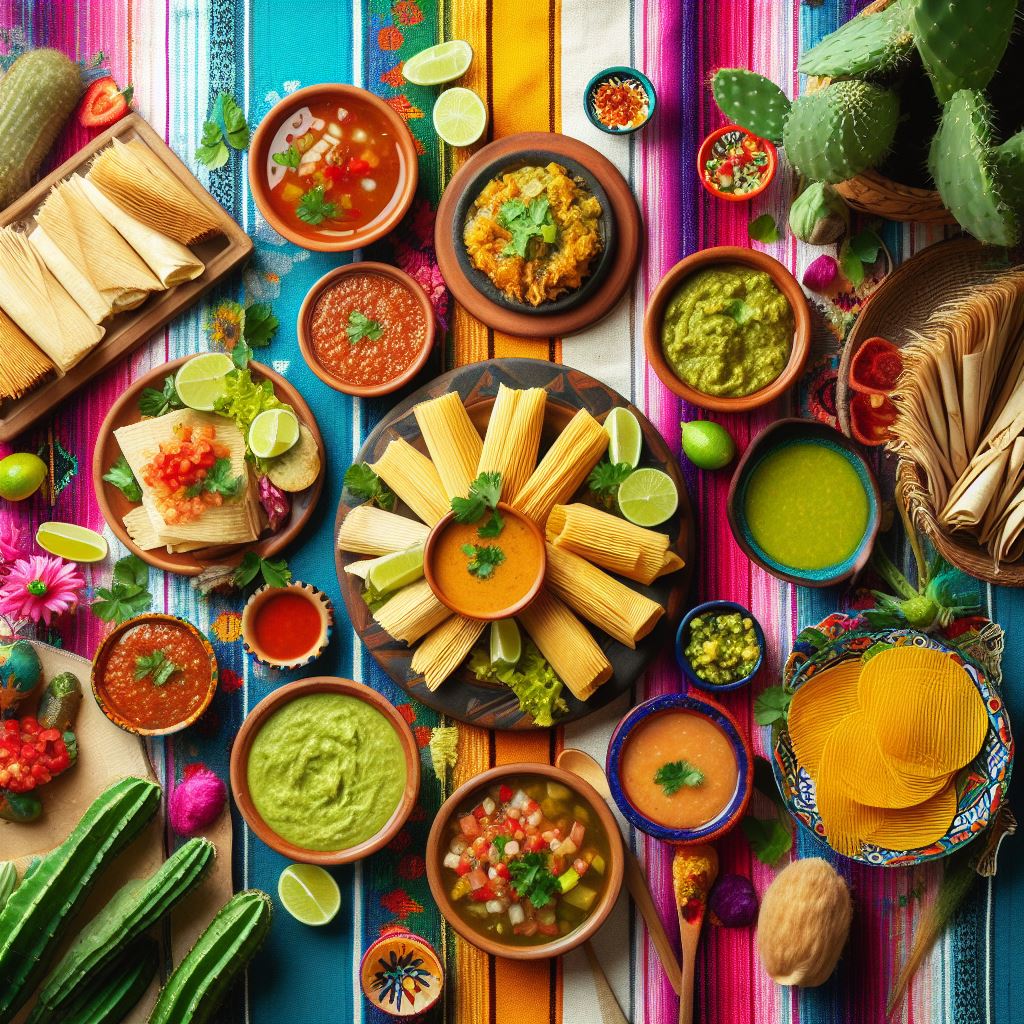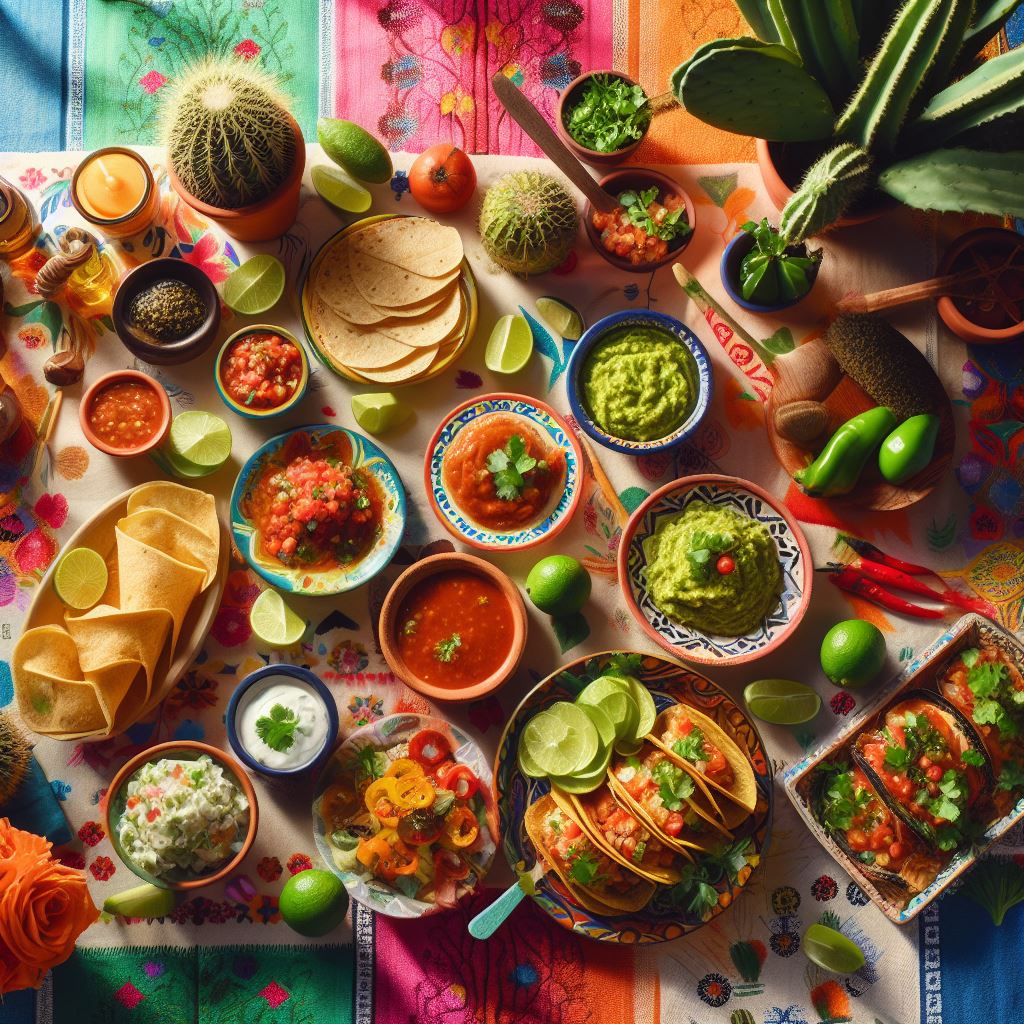The Deep Dive: Unraveling the Tantalizing Secrets of Mexican Cuisine
Living in the vibrant city of Los Angeles with its large Mexican population has been an enriching and flavorful experience. Being immersed in a diverse community that embraces Mexican food culture has allowed me to delve deeper into the fascinating world of Mexican food. Everywhere I turn, I am surrounded by the tantalizing aromas and vibrant colors of authentic Mexican cuisine.
Thank you for reading this post, don't forget to subscribe!
From street vendors serving mouthwatering tacos to family-owned restaurants crafting traditional recipes passed down through generations, the culinary landscape of LA has become a gateway to understanding the essence of Mexican gastronomy. However, my curiosity and desire to truly immerse myself in the Mexican food culture went beyond the boundaries of LA.
Eager to explore the roots of this beloved cuisine, I embarked on a journey to Mexico, a country renowned for its culinary heritage. Stepping foot on Mexican soil, I was instantly captivated by the vibrant energy and the sheer love Mexicans have for their food. The sights, sounds, and tastes of Mexico opened new doors of understanding, revealing the depth and complexity of this rich culinary tradition. From the bustling food markets with their colorful displays of fresh produce and fragrant spices to the humble street food stalls serving up sizzling delights, every moment in Mexico was a captivating lesson in the art of Mexican cuisine.
In the bustling streets of Mexico City, I found myself indulging in authentic dishes like mole poblano, a complex sauce made with chili peppers and chocolate, and savory tamales wrapped in corn husks. Each bite was a revelation, showcasing the careful balance of flavors and the intricate blend of traditional ingredients. Beyond the iconic dishes, I discovered the importance of regional variations and the significance of ancestral techniques passed down through generations.
In Oaxaca, I witnessed the labor-intensive process of making traditional tortillas by hand, marveling at the skill and dedication required to create such a simple yet essential staple. Traveling through the diverse Mexican landscapes, from the coastal regions with their bountiful seafood to the arid deserts of the north, I encountered a tapestry of culinary traditions.
In Puebla, I savored the aromatic spices of traditional mole dishes, while in Yucatán, I feasted on succulent cochinita pibil, a slow-roasted pork delicacy marinated in citrus and achiote paste. Each region had its unique culinary identity, shaped by cultural influences and local produce, offering a glimpse into the immense diversity of Mexican cuisine.
Throughout my journey, I had the privilege of engaging with passionate cooks, street vendors, and home cooks who graciously shared their knowledge and love for Mexican food. From learning the secret family recipes to participating in cooking workshops, I gained invaluable insights into the techniques and traditions that make Mexican cuisine so extraordinary.
Every interaction deepened my appreciation for the cultural significance of food in Mexico, where meals serve as a vehicle for storytelling, celebration, and connection. Returning to Los Angeles with a heart full of cherished memories and a newfound appreciation for Mexican food culture, I continue to explore and embrace the culinary treasures that this vibrant city has to offer.
The fusion of Mexican flavors with American influences has resulted in a unique and exciting culinary landscape in LA, where innovative chefs push the boundaries of tradition while honoring the essence of Mexican gastronomy. Living in a city that celebrates the rich tapestry of Mexican culture and having experienced the beauty of Mexico firsthand, I am forever grateful for the opportunity to be immersed in this extraordinary world of flavors, colors, and traditions.
Introduction To Mexican Food Culture
- Mexican cuisine blends indigenous and Spanish influences.
- Key staple foods in Mexican cuisine include corn, beans, and chilies, with corn being consumed in various forms, including tortillas.
- Commonly used herbs and spices in Mexican cooking include cilantro, thyme, cumin, and cinnamon.
- Fruits and vegetables such as tomatoes, tomatillos, avocado, mango, and papaya are widely used in salsas and sauces.
- Pinto beans are often served as a soupy-textured refried bean with tortillas.
- Mexican meat preferences include chicken (pollo asado), pork (carnitas), and beef (carne), with more seafood options in coastal cities.
- Meals in Mexico consist of breakfast (desayuno), lunch (comida), and supper (cena), with lunch being the most significant.
- Popular beverages in Mexico include soft drinks like Coca-Cola, fruit juice-based drinks, beer (cerveza), and tequila, which has a protected designation of origin (PDO) status.
- Dining etiquette includes waiting for the host’s invitation to start eating, keeping the knife and fork in specific hands, and resting hands on the table when not holding utensils.
- The head of the table and the seat to the right of the host are considered the most honored positions in dining etiquette.
- Tequila is typically served as a shot with salt and lime or in a margarita.
Overall, this web page provides insights into the customs and cuisine of Mexico, highlighting the significance of certain foods and beverages, as well as dining etiquette practices.
Mexican cuisine, renowned for its vibrant flavors, rich history, and diverse palate, is more than just a meal. It is an immersive journey through history, culture, and tradition. As enthusiasts of global gastronomy, we are excited to share this journey with you, delving deep into the nuances and tales of Mexican food culture.
Mexican cuisine has been recognized as Intangible Cultural Heritage of Humanity by UNESCO since 2010.
The Pillars of Mexican Gastronomy

Historical Tapestry of Culinary Evolution
The evolution of Mexican food cannot be traced without acknowledging its deep-rooted origins in pre-Hispanic times. The amalgamation of native ingredients and methods with those introduced by the Spanish has led to the creation of dishes that tell tales of cultural integration. Take the classic “Pollo con mole,” for instance. While the primary components, cacao and chile, are indigenous to Mexico, many spices and even the chicken itself were introduced by the Spanish.
A Symphony of Flavors and Colors
Mexican dishes are not just about taste. They are a celebration of colors, shapes, and occasions. A single plate can encapsulate various textures and flavors, making each bite a unique experience. The pozole, a traditional soup, is a testament to this, combining harmony and balance in every spoonful.
The Art of Culinary Innovation
The foundation of many beloved Mexican dishes is often a blend of creativity and serendipity. Stories abound of individuals or communities stumbling upon innovative cooking methods or ingredient substitutions. A notable example is “Los Chiles en Nogada,” which hails from Puebla and was crafted to commemorate the centennial of Mexican independence.
A Mosaic of Regional Delights
The vastness of Mexico’s geography, comprising 32 distinct states, translates into a culinary landscape of astonishing variety. From the “Tikin Xic fish” of Quintana Roo to the “Sopa de pan” in Chiapas, each region boasts its unique specialty, showcasing the nation’s rich biodiversity.
Echoes of Ancestral Practices
Sustainability: Milpa and Chinampas
Mexican agriculture has long been guided by sustainable practices rooted in tradition. The “milpa,” a piece of land where corn is cultivated, is not just about this staple grain. It’s a polyculture system where squash, beans, and other crops coexist, sharing resources like water and soil.
Similarly, the “chinampa” represents an ingenious method of farming on lakes. These floating gardens, dating back to the Aztec era, produce an array of crops from flowers to vegetables.
Exquisite Fusion of Ingredients
Mexican cuisine thrives on its ability to surprise and delight with its innovative use of ingredients. This is evident in its blend of chilies with chocolate, the juxtaposition of fruits and meats, and even the incorporation of insects. The “quesadilla de huitlacoche” highlights the corn’s fungus, turning it into a culinary delight, while salsas made from chapulines, Jumiles, and chicatanas emphasize the versatility of this cuisine.
The Essence of Mealtime in Mexico
Modern times have inevitably altered some dining traditions. However, the essence of Mexican mealtimes, emphasizing family and togetherness, remains strong. Traditionally, the main lunchtime, “La hora de la comida,” is observed between 2 and 3 pm. The setting is elaborate, with families gathering around tables laden with condiments, beverages, and a variety of dishes.
For those unable to return home during work hours, the “cocina económica” offers an affordable solution. These eateries, often family-run, serve a limited menu of homemade dishes at a fraction of restaurant prices.
Wrapping Up the Culinary Journey
Mexican cuisine is not just a list of popular dishes. It embodies a profound journey through history, tradition, innovation, and regional diversity. As we delve deeper into its myriad layers, we uncover stories of civilizations, revolutions, and the undying spirit of a nation that has turned food into an art form. Embracing and celebrating these stories, we invite you to relish the intricacies of Mexican gastronomy, which, much like its dishes, offers a symphony of experiences in every morsel.
Traditional Mexican Food Recipes
Traditional Mexican food recipes are celebrated for their vibrant flavors, colorful presentation, and rich cultural heritage. The culinary traditions of Mexico have been shaped by a fusion of indigenous ingredients and cooking techniques with Spanish and other European influences. These recipes reflect the diverse regional variations within Mexico, showcasing the country’s vast culinary landscape.
One iconic traditional Mexican dish is the flavorful and aromatic Mole Poblano. Originating from the state of Puebla, this complex sauce is made with a blend of spices, nuts, seeds, and chocolate, creating a harmonious balance of flavors. The sauce is then typically served over slow-cooked chicken or turkey, resulting in a dish that is both savory and delightfully unique.
Another beloved Mexican recipe is Tamales, which have been enjoyed for centuries. These steamed corn dough pockets are filled with a variety of savory or sweet fillings, such as slow-cooked meats, cheeses, vegetables, or fruits. Wrapped in corn husks or banana leaves, tamales are cooked until tender and are often enjoyed during festive occasions or holidays.
Enchiladas, another classic Mexican dish, are made by rolling tortillas around a filling, commonly filled with shredded chicken or cheese, and then smothered in a spicy tomato or chili sauce. Topped with melted cheese, sour cream, and fresh herbs, enchiladas offer a burst of flavor with every bite and are a staple in Mexican cuisine.
For those seeking a refreshing and healthy option, traditional Mexican ceviche is a must-try. This seafood dish typically consists of fresh raw fish or shrimp marinated in lime juice, mixed with diced tomatoes, onions, cilantro, and sometimes avocado. The acidity of the lime juice “cooks” the fish, resulting in a zesty and refreshing dish that is perfect for warm summer days.
Guacamole, a well-known Mexican recipe, is now enjoyed worldwide. Made by mashing ripe avocados with lime juice, onions, tomatoes, and cilantro, this creamy and flavorful dip is a staple in Mexican cuisine. It can be easily customized with additional ingredients like jalapeños or roasted corn to suit individual preferences.
In addition to these iconic dishes, Mexico also boasts a wide variety of regional specialties, such as Pozole from Jalisco, Chiles Rellenos from Puebla, and Cochinita Pibil from Yucatan. Each region showcases its unique flavors and culinary traditions, offering a diverse and exciting culinary journey for food lovers. Traditional Mexican food recipes not only tantalize the taste buds but also provide a glimpse into the country’s rich history and cultural heritage.
The use of fresh ingredients, bold spices, and intricate cooking techniques creates a gastronomic experience that is truly remarkable. Whether enjoyed in a vibrant Mexican Mercado, a cozy family kitchen, or a bustling restaurant, these recipes have the power to transport you to the heart of Mexico. So, next time you have the opportunity, dive into the world of traditional Mexican cuisine and savor the vibrant flavors that have been perfected over generations.


